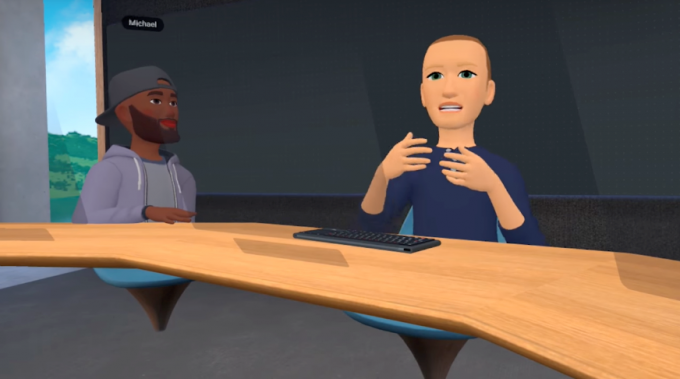Facebook may be traveling along a well-worn path to failure with a recycled vision of interactive 3D collaboration in VR.
Facebook introduced Horizon Workrooms, its take on the metaverse and so far it seems to have had a very hard landing. It’s never a good sign when a technology introduction gets more attention in the mainstream press than in the tech press. Worse, the press is having a field day with Facebook’s latest scheme to find relevancy for VR within social media.
Our first impulse was to ignore the introduction. We’re way behind on more important technology introductions and the whole idea looks like an elaboration on an old theme. We are covering this because (A) it’s possible we’re being opinionated jerks, and (B) it’s our job to provide information on new technology. Especially technology that takes advantage of computer graphics breakthroughs.
Anyway, we need baseline against which to compare different approaches such as Varjo and adjacent efforts like Omniverse, and projects from Unreal and Unity.
In a presentation of Horizon Workrooms with several just folks participants, Facebook CEO Mark Zuckerberg described Workrooms as an embodied internet that you’re inside of rather than just looking at and he said, “we have an idea that the metaverse will replace the Internet.”

People who used it said the fact that their avatars moved with them, and 3D sound added to spatial awareness as voices came from the direction of the avatars in the room, really sold the illusion. Participants in Horizon are represented as floating figures more or less from the butt up, no legs but very fluid head and hand movement. The app maps the head and hand information from the headset of the participant to the avatars.
As a cautionary note, hand movements seem to be emphasized to the point that people seem distraught if you’re not listening to them but just seeing them wave their hands.
As of now, Workrooms can accommodate up to16 VR headset users. Before getting started, users can customize their avatar to get a more personalized version of themselves.
In his talks about technology, Zuckerberg said that they’re hoping to establish standards to allow avatars to carry over to different environments. The app will also support many more video callers—up to 50 participants in a single meeting.
A cool feature is an overlay that lets you see your computer screen. So, while attending a meeting, you can see your computer to take notes, look up relevant data, or maybe check your email. You can keep your screen private or share it with others. The virtual whiteboard lets users share images, draw and highlight, or make presentations.
These capabilities are enabled through features added to the Oculus 2. Facebook says features like mixed reality desk, keyboard tracking, hand tracking, remote desktop streaming, video conferencing integration, spatial audio, and the new Oculus Avatars enable “a different kind of productivity experience.”
Obviously, there have been several attempts to develop immersive interaction that can more closely approximate a face-to-face encounter and I don’t know any that could be called a raving success. Please feel free to correct me.
Facebook’s Oculus team is clear about understanding the challenge. Facebook Horizon is the umbrella term for their metaverse efforts. It’s in beta now and it seems to be in a very fluid state as Facebook tries to figure out its immersive strategy while building it. To be fair, that’s really not much different from anyone else. Nvidia’s Omniverse has been an evolving idea that began as a desire to build “the Holodeck.” AMD has also talked about its Holodeck plans.
In the past, Facebook has introduced Oculus Rooms, and Facebook Spaces—both allowed people to meet in VR, and Sony did it 10 years ago. Horizon is the successor to those efforts. So, while we’re having trouble working up enthusiasm for this particular manifestation of the desire to become one with the technology, there’s really not much sense slagging it before more people get a chance to play with it and tell Facebook what they’re doing wrong or right.
What do we think?
Here’s what I do believe. The metaverse is coming. It’s building itself right now and when it eventually becomes real enough to captivate us there’ll be all sorts of ways to participate. In this, Zuckerberg has a strong point. The metaverse could very well become the next iteration of the internet.
I’ve been pretty clear about not liking Workrooms much. I like VR but I don’t like VR headsets. Headsets are what we have now, but it doesn’t seem like the right technology for people to inhabit the digital world. And, not to put too fine a point on it, if people won’t wear masks to save their lives, they’re sure as hell not going to wear headsets to go to work.
Where we’re going instead is probably foreshadowed more by autonomous vehicles—we’ll get there through sensors and cameras and by previous attempts to build shared spaces.
The thing I find particularly offputting about Facebook’s brand of a VR environment is that it’s infantilizing. I don’t want to be a cartoon in my business meetings, nor do I want to see my colleagues that way— the metaphor sometimes hits a little close to home. Say what you will about the never-successful Second Life, it was designed for adults. So is Spatial, and Varjo Workspace. Nvidia’s collaborative workspace used robotish characters. It has since evolved into Omniverse.
It really is a road and the technology is just at the start of it. And yes, it’s been at that start point for more than a decade. Second Life debuted in 2003.
We all blame everything on the pandemic, and this is just one more thing: the pandemic has highlighted the ways in which we work remotely together are failing us. These new technologies are being developed after a period in which we’ve all experienced the stuff that doesn’t work. That’s a pretty good position to start from.






